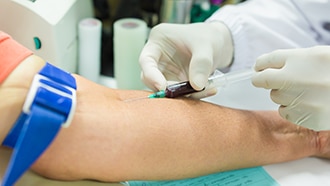What Does an Insulin Level Test Tell Us
On this page:
- What is insulin?
- What is insulin resistance?
- What is prediabetes?
- How common is prediabetes?
- Who is more likely to develop insulin resistance or prediabetes?
- What causes insulin resistance and prediabetes?
- What are the symptoms of insulin resistance and prediabetes?
- How do doctors diagnose insulin resistance and prediabetes?
- How can I prevent or reverse insulin resistance and prediabetes?
- Clinical Trials
Insulin resistance and prediabetes occur when your body doesn't use insulin well.
What is insulin?
Insulin is a hormone made by the pancreas that helps glucose in your blood enter cells in your muscle, fat, and liver, where it's used for energy. Glucose comes from the food you eat. The liver also makes glucose in times of need, such as when you're fasting. When blood glucose, also called blood sugar, levels rise after you eat, your pancreas releases insulin into the blood. Insulin then lowers blood glucose to keep it in the normal range.
What is insulin resistance?
Insulin resistance is when cells in your muscles, fat, and liver don't respond well to insulin and can't easily take up glucose from your blood. As a result, your pancreas makes more insulin to help glucose enter your cells. As long as your pancreas can make enough insulin to overcome your cells' weak response to insulin, your blood glucose levels will stay in the healthy range.
What is prediabetes?
Prediabetes means your blood glucose levels are higher than normal but not high enough to be diagnosed as diabetes. Prediabetes usually occurs in people who already have some insulin resistance or whose beta cells in the pancreas aren't making enough insulin to keep blood glucose in the normal range. Without enough insulin, extra glucose stays in your bloodstream rather than entering your cells. Over time, you could develop type 2 diabetes.
How common is prediabetes?
More than 84 million people ages 18 and older have prediabetes in the United States.1 That's about 1 out of every 3 adults.
Who is more likely to develop insulin resistance or prediabetes?
People who have genetic or lifestyle risk factors are more likely to develop insulin resistance or prediabetes. Risk factors include
- overweight or obesity
- age 45 or older
- a parent, brother, or sister with diabetes
- African American, Alaska Native, American Indian, Asian American, Hispanic/Latino, Native Hawaiian, or Pacific Islander American ethnicity
- physical inactivity
- health conditions such as high blood pressure and abnormal cholesterol levels
- a history of gestational diabetes
- a history of heart disease or stroke
- polycystic ovary syndrome, also called PCOS
People who have metabolic syndrome—a combination of high blood pressure, abnormal cholesterol levels, and large waist size—are more likely to have prediabetes.
Along with these risk factors, other things that may contribute to insulin resistance include
- certain medicines, such as glucocorticoids, some antipsychotics, and some medicines for HIV
- hormonal disorders, such as Cushing's syndrome and acromegaly
- sleep problems, especially sleep apnea
Although you can't change risk factors such as family history, age, or ethnicity, you can change lifestyle risk factors around eating, physical activity, and weight. These lifestyle changes can lower your chances of developing insulin resistance or prediabetes.

What causes insulin resistance and prediabetes?
Researchers don't fully understand what causes insulin resistance and prediabetes, but they think excess weight and lack of physical activity are major factors.
Excess weight
Experts believe obesity, especially too much fat in the abdomen and around the organs, called visceral fat, is a main cause of insulin resistance. A waist measurement of 40 inches or more for men and 35 inches or more for women is linked to insulin resistance. This is true even if your body mass index (BMI) falls within the normal range. However, research has shown that Asian Americans may have an increased risk for insulin resistance even without a high BMI.
Researchers used to think that fat tissue was only for energy storage. However, studies have shown that belly fat makes hormones and other substances that can contribute to chronic, or long-lasting, inflammation in the body. Inflammation may play a role in insulin resistance, type 2 diabetes, and cardiovascular disease.
Excess weight may lead to insulin resistance, which in turn may play a part in the development of fatty liver disease.
Physical inactivity
Not getting enough physical activity is linked to insulin resistance and prediabetes. Regular physical activity causes changes in your body that make it better able to keep your blood glucose levels in balance.
What are the symptoms of insulin resistance and prediabetes?
Insulin resistance and prediabetes usually have no symptoms. Some people with prediabetes may have darkened skin in the armpit or on the back and sides of the neck, a condition called acanthosis nigricans. Many small skin growths called skin tags often appear in these same areas.
Even though blood glucose levels are not high enough to cause symptoms for most people, a few research studies have shown that some people with prediabetes may already have early changes in their eyes that can lead to retinopathy. This problem more often occurs in people with diabetes.
How do doctors diagnose insulin resistance and prediabetes?
Doctors use blood tests to find out if someone has prediabetes, but they don't usually test for insulin resistance. The most accurate test for insulin resistance is complicated and used mostly for research.

Doctors most often use the fasting plasma glucose (FPG) test or the A1C test to diagnose prediabetes. Less often, doctors use the oral glucose tolerance test (OGTT), which is more expensive and not as easy to give.
The A1C test reflects your average blood glucose over the past 3 months. The FPG and OGTT show your blood glucose level at the time of the test. The A1C test is not as sensitive as the other tests. In some people, it may miss prediabetes that the OGTT could catch. The OGTT can identify how your body handles glucose after a meal—often before your fasting blood glucose level becomes abnormal. Often doctors use the OGTT to check for gestational diabetes, a type of diabetes that develops during pregnancy.
People with prediabetes have up to a 50 percent chance of developing diabetes over the next 5 to 10 years. You can take steps to manage your prediabetes and prevent type 2 diabetes.
The following test results show Prediabetes2
- A1C—5.7 to 6.4 percent
- FPG—100 to 125 mg/dL (milligrams per deciliter)
- OGTT—140 to 199 mg/dL
You should be tested for prediabetes if you are overweight or have obesity and have one or more other risk factors for diabetes, or if your parents, siblings, or children have type 2 diabetes. Even if you don't have risk factors, you should start getting tested once you reach age 45.
If the results are normal but you have other risk factors for diabetes, you should be retested at least every 3 years.2
How can I prevent or reverse insulin resistance and prediabetes?
Physical activity and losing weight if you need to may help your body respond better to insulin. Taking small steps, such as eating healthier foods and moving more to lose weight, can help reverse insulin resistance and prevent or delay type 2 diabetes in people with prediabetes.

The National Institutes of Health-funded research study, the Diabetes Prevention Program (DPP), showed that for people at high risk of developing diabetes, losing 5 to 7 percent of their starting weight helped reduce their chance of developing the disease.3 That's 10 to 14 pounds for someone who weighs 200 pounds. People in the study lost weight by changing their diet and being more physically active.
The DPP also showed that taking metformin, a medicine used to treat diabetes, could delay diabetes. Metformin worked best for women with a history of gestational diabetes, younger adults, and people with obesity. Ask your doctor if metformin might be right for you.
Making a plan, tracking your progress, and getting support from your health care professional, family, and friends can help you make lifestyle changes that may prevent or reverse insulin resistance and prediabetes. You may be able to take part in a lifestyle change program as part of the National Diabetes Prevention Program.
Clinical Trials
The National Institute of Diabetes and Digestive and Kidney Diseases (NIDDK) and other components of the National Institutes of Health (NIH) conduct and support research into many diseases and conditions.
What are clinical trials, and are they right for you?
Clinical trials are part of clinical research and at the heart of all medical advances. Clinical trials look at new ways to prevent, detect, or treat disease. Researchers also use clinical trials to look at other aspects of care, such as improving the quality of life for people with chronic illnesses. Find out if clinical trials are right for you.
What clinical trials are open?
Clinical trials that are currently open and are recruiting can be viewed at www.ClinicalTrials.gov.
References
What Does an Insulin Level Test Tell Us
Source: https://www.niddk.nih.gov/health-information/diabetes/overview/what-is-diabetes/prediabetes-insulin-resistance
0 Response to "What Does an Insulin Level Test Tell Us"
Post a Comment